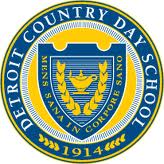Last week I visited a wigwam made by 4th graders, and a tinker toy village, before later visiting a Theory of Knowledge classroom of Upper School students try to stump one another on the topic of Occam's Razor in a review competition. In my dual role as Upper School Head, and PK - 12 Chief Academic officer, I get the pleasure of visiting classrooms across the learning spectrum. The opportunity to see where kids start, and to what heights they grow, and to see it in the same day is a powerful way to develop a picture of a school's curriculum coming to life. As students progress through grade levels and content areas, and mature to more sophisticated concepts, a truism is that levels of student engagement often drop considerably. Crawling in and out of a wigwam can seem like a lot more fun that logarithms, slope, or Puritan literature. It's a good reminder to all of us that some of the principles of elementary education can apply to keeping student engagment levels high at the upper grades.
Blogger Doug Johnson posted recently on maintaining student engagement levels. He created
Everything I Know about Engagement I Learned in Kindergarten:
In kindergarten we get:
1. Show and tell. You got to do something or bring something and then tell others about it. Secondary skill attainment measurement needs to be less about testing and more about show and tell performance-based assessment. Oh, and listening to other students is a lot more involving than listening to the old person in the room.
2. Choices. As a little kid you often got to choose - your library book, your reading buddy, your activity, the subject of your drawing. People tend to choose things that interest them and interesting things are engaging. How often do we let older students choose?
3. Play. Elementary teachers can make a game out of almost anything - and make just about every task feel like play. The older we get, the less we get to play and more we have to work. Just why is that? Gamification is a fancy term for putting play back into the curriculum. Look it up.
4. Naps. Most adolescents I know are tired - and not because they've been up all night texting. (Well, maybe that's part of it.) We've long known that teens do better when school starts later in the morning. Tired people have a tough time staying engaged.
5. To go outside. The best learning takes place in the "real world" not in the classroom. Whether it is studying bugs and leaves in first grade, marching with the band in junior high, or doing service learning as seniors, we all are more interested when it is the real world with which we are dealing.
6. Colors. A blank sheet of construction paper and some crayolas have always let young learners be creative. Creativity is inherently engaging. What's the high school classroom's equivilant to scissors and paste?
7. To do it together. Reading groups. Play groups. Science groups. It's better with other kids. Social learners are engaged learners.
8. Reading for enjoyment. Our elementary teachers and librarians want us to practice reading so much they let us read what we like! Do our secondary teachers want us to write so much, know so much, experiment so much, and solve problems so much that we get to do it for enjoyment?
9. Learning that's important. Nobody needs to convince a little kid that learning to read, to add and subtract, or to know about firemen is important. And that you should pay attention when being taught these things. Calculus, world history, the Romantic poets, the atomic structure of non-metals, not so much. If you can't convince me what you are teaching should be important to me, teach something that is.
10. Care. OK, this should have been the first one. I really believe a lot little kids are engaged because they know someone cares that they are. Yeah, the littles are cute and cuddly and all that, but the gangly, awkward, homely teens need to know adults care too. When someone else is paying attention to you, you pay more attention yourself.
All teachers, at all levels, have a responsibility to develop engaging lessons that make classroom learning relevant. It's a legitimate question for students to ask what relevance content will have to them beyond school. In an engaging classroom that follows the rules of kindergarten, that questions is rarely asked because the answers are obvious. This challenge grows with the sophistication of material, but these rules of kindergarten are great reminders for parents and teachers alike that learning can, and should be, stimulating, engaging, and fun.
